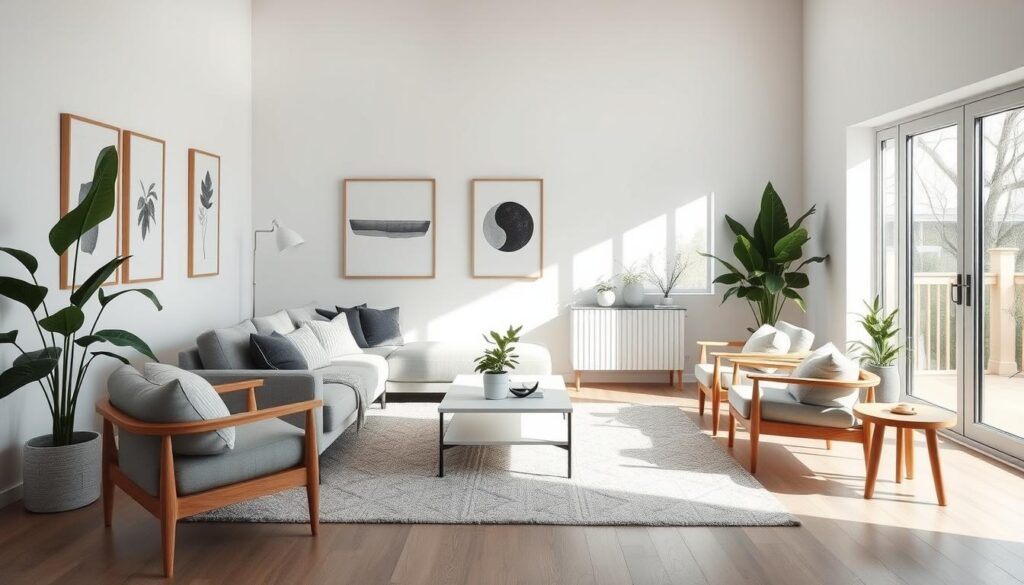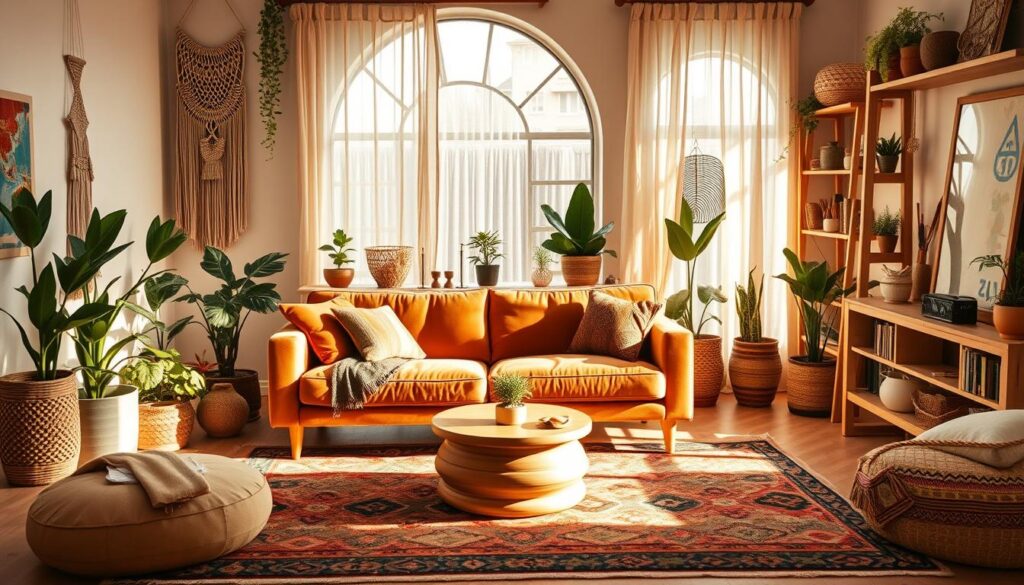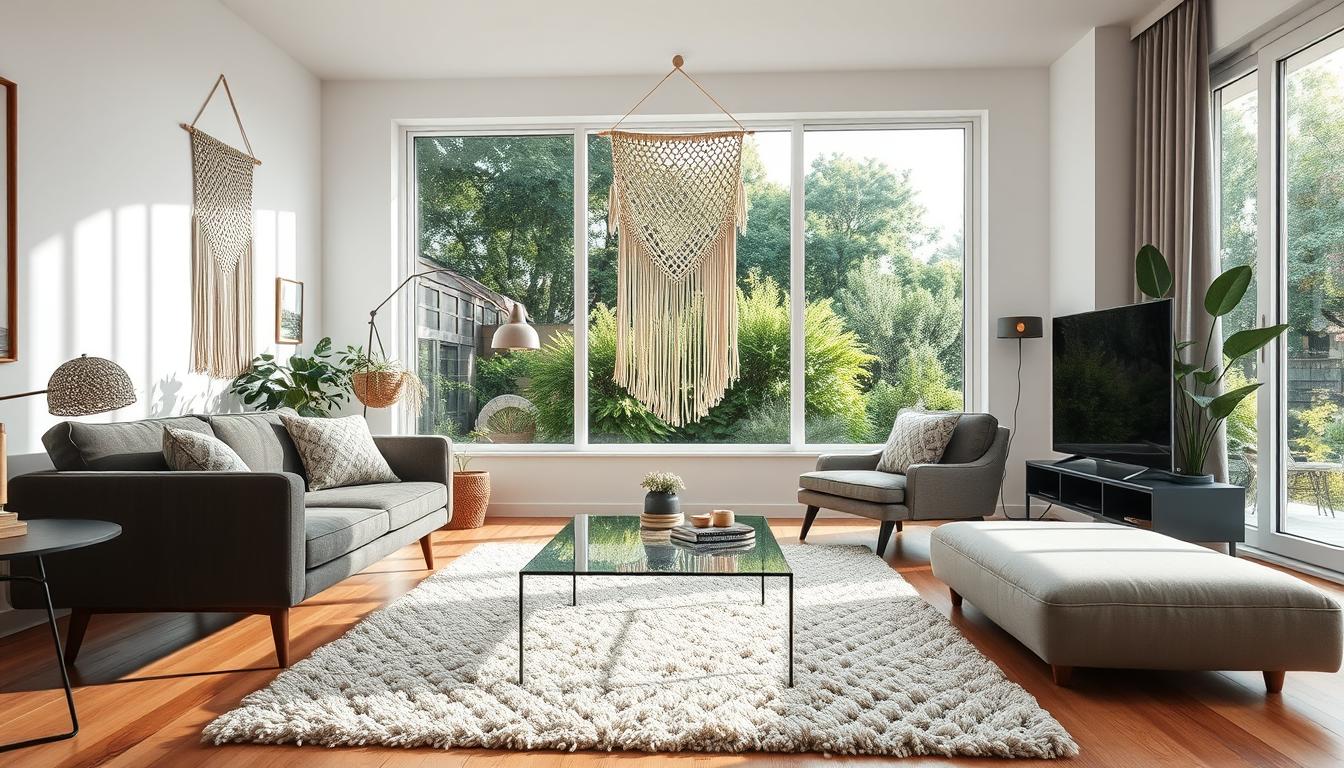Did you know that how we design our homes can really affect our mood and well-being? With so many interior design styles out there, picking the right one can be tough.
As we look at the various styles, it’s key to know what each one is about. This way, you can create a space that shows off your personality and meets your needs. We’ll walk you through the top styles, helping you choose wisely.
Key Takeaways
- Understanding the characteristics of different interior design styles
- Exploring the top styles to transform your living space
- Creating a space that reflects your personality and meets your needs
- Making an informed decision when choosing a design style
- Transforming your home with the right interior design style
Understanding Home Interior Design Styles
The art of interior design makes a building’s inside better and more beautiful. It’s not just about adding decorations. It’s about making a space that shows who we are and meets our needs.
What is Interior Design?
Interior design is a complex field. It involves knowing what people want and need, picking a style that fits, and using knowledge of materials, lighting, and space. Whether you like modern interior design or something else, the aim is to make a space that works well and looks good.
Importance of Choosing a Style
Picking the right interior design style is key. It greatly affects how our home feels and works. For example, traditional interior design uses classic and detailed elements, making a cozy and welcoming space. By choosing a style that matches our life and taste, we can make our home feel truly ours.
Also, the style we pick can change how we feel and work. A well-designed space can make us feel more energetic and happy. So, knowing about different interior design styles and what they offer is important for designing our homes.
Traditional Interior Design Style
Traditional interior design adds warmth and elegance to any home. It’s all about classic elements, rich colors, and detailed designs. This style makes any room feel cozy and luxurious, which is why many people love it.
Key Characteristics of Traditional Design
The traditional style stands out with its unique features. It often includes warm colors, fancy furniture, and classic patterns like damask and florals.
- Rich, warm color palettes
- Ornate furnishings and decor
- Classic patterns such as damask and florals
- High-quality, durable materials
- Antique or antique-inspired pieces
Best Color Schemes for Traditional Spaces
Choosing the right colors is key in traditional design. Warm, earthy tones are perfect for creating a welcoming feel.
| Color | Description |
|---|---|
| Warm Beige | A neutral background that complements rich furnishings |
| Rich Red | Adds a sense of luxury and sophistication |
| Soft Cream | Creates a soft, elegant ambiance |
“The beauty of traditional design lies in its ability to blend the old with the new, creating a unique and inviting space.”
Modern Interior Design Style
Modern interior design focuses on clean lines and minimal decoration. It aims to create a space that feels open and clutter-free. This style is great for those who love simplicity and elegance.
Defining Features of Modern Design
Modern interior design has several key features:
- Clean Lines: Furniture and architectural elements have straight lines and few curves. This adds to the simplicity and order of the space.
- Minimal Ornamentation: Unlike traditional designs, modern design is simple. It focuses on the essence of materials and forms.
- Functionality: Every piece in a modern interior has a purpose. It could be for storage, seating, or lighting. This makes the space both beautiful and practical.
Popular Materials for Modern Interiors
The choice of materials is key in modern interior design. Some top picks include:
| Material | Characteristics | Uses |
|---|---|---|
| Glass | Transparent, sleek, and modern | Tables, shelving, partitions |
| Steel | Strong, durable, and versatile | Furniture frames, lighting fixtures, decorative accents |
| Concrete | Raw, industrial, and highly versatile | Flooring, walls, countertops |
Using these materials and sticking to modern design principles can create a stylish and functional interior.
Contemporary Interior Design Style
Interior design today focuses on trying new things and being creative. It’s not just about following the latest trends. It’s about making a space that’s modern and shows off your personal style.
What Sets Contemporary Apart from Modern
Many people mix up contemporary and modern design. But they’re different. Contemporary design is all about being flexible and open to change. It’s not stuck in one era like modern design.
It’s about:
- Trying out new materials and tech
- Being green and eco-friendly
- Bringing in different cultures
- Being ready to change and grow
This openness makes contemporary design great for those who love new ideas and are ready for anything.
Color Trends in Contemporary Design
Colors are very important in contemporary design. Trends often go for bold and unique colors. Some popular colors right now are:
- Monochromatic Neutrals: Using different shades of one color for a unified look.
- Bold Accent Colors: Adding bright colors through furniture or decor to make a room pop.
- Earth Tones: Using colors inspired by nature to add warmth and coziness.
These colors show what’s in style today. They also fit with the minimalist style by keeping things simple and useful.
Industrial Interior Design Style
In recent years, the industrial interior design style has gained popularity. It adds grit and character to homes. This style celebrates the beauty of old factories and warehouses.
The industrial style focuses on functionality and raw materials. It tells a story, often using elements from old industrial spaces.
Elements of Industrial Design
Several key elements define the industrial interior design style. These include:
- Exposed brick and concrete, which add a raw, unfinished look to a room.
- Metal beams and pipes, often left exposed to highlight the structural elements of the building.
- Reclaimed wood, used for flooring, walls, or furniture, adding warmth to the space.
- Industrial lighting, such as metal pendant lights or exposed bulbs, which contribute to the overall aesthetic.
How to Incorporate Industrial Features at Home
Incorporating industrial design elements into your home is easy. Here are a few tips:
Start by adding industrial elements through furniture and decor. Use metal tables or industrial-style lighting fixtures. If you’re feeling adventurous, expose brick or concrete by removing plaster or drywall. Reclaimed wood can be used for flooring or to create a statement wall.
To balance the ruggedness, add softer textures and warmer tones. Use textiles, rugs, and upholstery. This blend will make your space cozy and inviting while keeping the industrial edge.
By incorporating industrial design elements, you can create a unique and captivating living space. It will reflect your personal style.
Scandinavian Interior Design Style
Scandinavian interior design is known for its mix of minimalism and warmth. It’s loved worldwide for its cozy feel. Homeowners often choose it for its peaceful vibe.
At its heart, Scandinavian design balances form and function. It’s simple, comfortable, and connects us to nature. Let’s dive into what makes it special.
Core Principles of Scandinavian Design
Scandinavian design focuses on minimalism, functionality, and being green. It aims to create spaces that are beautiful, useful, and good for the planet. Natural materials like wood and linen add warmth and texture.
Key Elements of Scandinavian Design:
- Simple, clean lines
- Minimal ornamentation
- Emphasis on natural materials
- Functionality and practicality
Minimalism in Scandinavian Interiors
Minimalism is key in Scandinavian design. It’s about removing the unnecessary to show the space’s true nature. This makes for a calm, clutter-free area, ideal for unwinding. The interiors often stick to a neutral color scheme, with whites, grays, and blacks leading the way.
Minimalist Scandinavian design makes spaces feel bigger and more peaceful. Natural light and mirrors help make these interiors feel even more open and airy.

Let’s compare different interior styles to see what makes Scandinavian design unique:
| Design Style | Key Features | Color Palette |
|---|---|---|
| Scandinavian | Minimalist, functional, natural materials | Neutral, with whites, grays, blacks |
| Traditional | Ornate, classic furniture, rich fabrics | Warm, with reds, golds, browns |
| Modern | Sleek, contemporary, innovative materials | Bold, with bright colors, metallics |
By grasping Scandinavian design’s core and embracing minimalism, we can craft spaces that are both beautiful and welcoming.
Farmhouse Interior Design Style
Farmhouse interior design is loved for its rustic charm and vintage vibe. It brings the warmth of rural life into our homes. This style is all about simplicity and coziness.
Rustic Elements
Farmhouse style stands out with its rustic materials and vintage interior design. Key features include:
- Reclaimed wood for furniture and flooring
- Vintage decor, such as antique fixtures and old metal signs
- Natural textiles, like linen and cotton, for upholstery and bedding
Creating a Cozy Atmosphere
To make a cozy farmhouse feel, we aim for warmth and comfort. Here are some tips:
- Use warm lighting, such as table lamps and candles, to create a soft glow.
- Incorporate natural elements, like potted plants and a vase with fresh flowers.
- Choose comfortable, oversized furniture with plush upholstery.
By following these tips, we can make our homes feel like a warm hug. It’s perfect for relaxing and enjoying time with loved ones.
Bohemian Interior Design Style
The Bohemian style celebrates free-spirited eclecticism in home decor. It values individuality and self-expression, making spaces unique and captivating.

Defining Traits of Bohemian Design
Bohemian design combines vintage and global elements, rich colors, and textures. It blends different cultures and eras, making spaces truly personal. Key traits include:
- Use of vintage furniture and antique pieces
- Incorporation of global influences, such as Moroccan tiles or Indian block-print fabrics
- A rich color palette with deep jewel tones and earthy hues
- Layered textures from rugs, throws, and pillows
To get a Bohemian look, start with vintage interior design pieces. Mix these with global influences and rich colors for a unique atmosphere.
Accessorizing a Bohemian Space
Accessorizing is key in Bohemian design, adding personality and character. Tips for accessorizing include:
- Adding rustic interior design elements, such as reclaimed wood furniture or natural fiber rugs
- Incorporating plants and greenery for a natural feel
- Using layered lighting, like table lamps and string lights, for warmth
- Displaying personal treasures, such as vintage collectibles or artwork, for interest
Embracing Bohemian design lets us create a home that shows our personality and style. Whether using vintage, global, or natural elements, the goal is to have fun and be creative.
Eclectic Interior Design Style
Eclectic interior design celebrates individuality and creativity in our homes. It’s about freedom and self-expression. We can mix different styles, periods, and textures to show our personality.
What Makes Eclectic Design Unique
Eclectic design is special because it combines many elements. It’s not just about mixing things; it’s about finding balance. The key to successful eclectic design is cohesion, which comes from a unifying theme, color, or texture.
Eclectic design is known for mixing modern with vintage or antique pieces. This mix creates a rich and interesting look that adds depth to our homes.
Tips for Achieving an Eclectic Look
To get an eclectic look, start with a core element or theme. This could be a standout piece of furniture, a bold color, or a unique texture. Then, add other elements that complement or contrast with it in interesting ways.
- Mix different styles, such as modern and traditional, to create visual interest.
- Experiment with a variety of textures, like smooth, rough, soft, and hard, to add depth.
- Don’t be afraid to incorporate unique or one-of-a-kind pieces that reflect your personality.
By embracing eclectic interior design, we can make spaces that are beautiful and personal. They reflect our tastes and experiences.
Choosing the Right Style for Our Home
There are many home interior design styles to pick from. Finding the right one can feel overwhelming. We need to think about our lifestyle, what we like, and our home’s architecture.
Assessing Personal Needs
First, we should figure out what we need and like. For example, a big family might like traditional design for comfort and practicality. Websites like modernointerior.com can help inspire our choices.
Blending Different Styles
We can mix different styles to make a space that’s uniquely ours. Combining traditional and modern elements can show off our personality. This way, we can create a space that’s both personal and functional.



